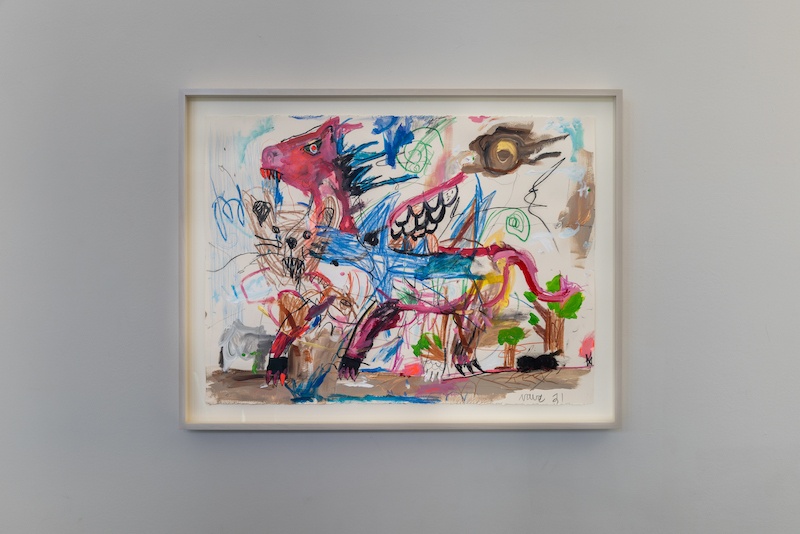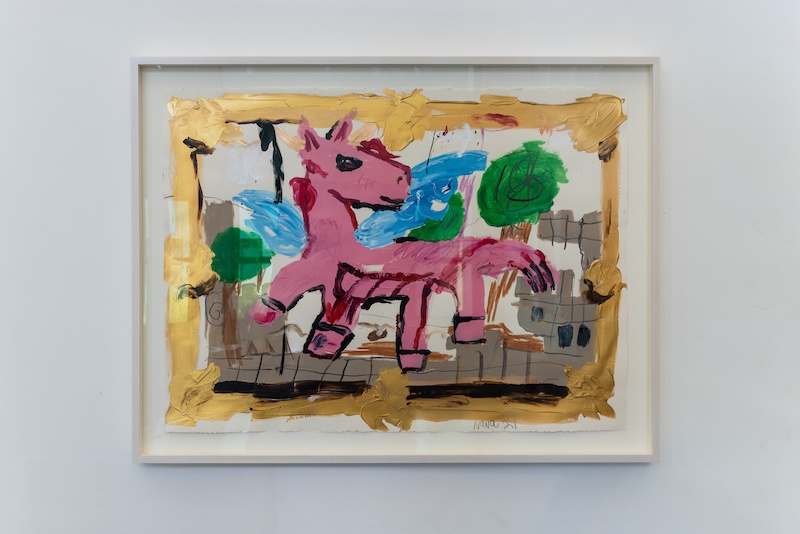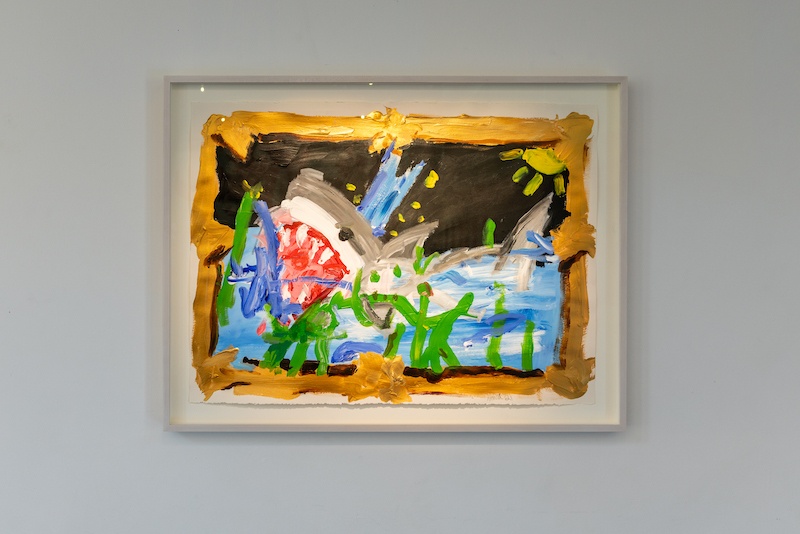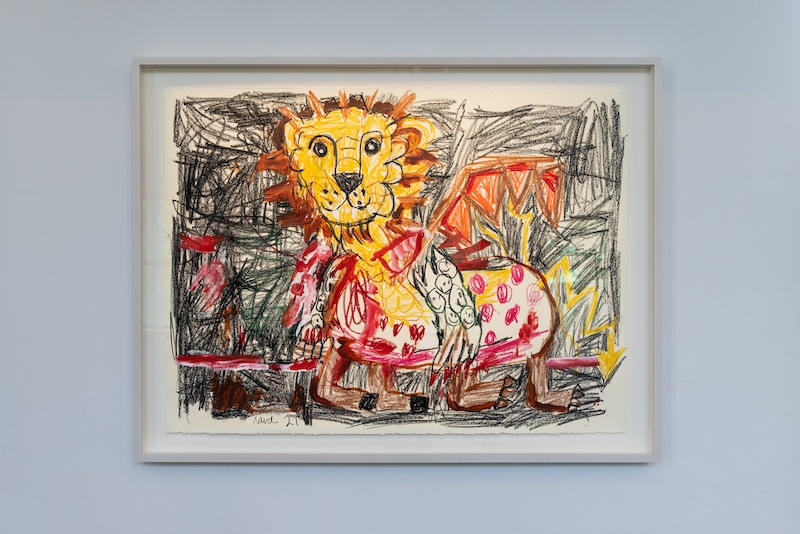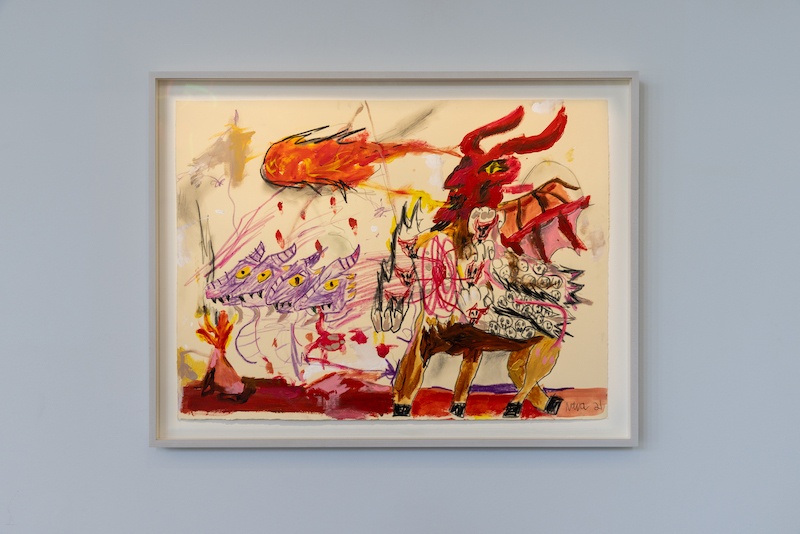Some people say there’s a child-like quality of your work. But I see specificity, as you hone in on certain areas and then pull back on others. What type of response can you share to those who’ve called the work juvenile?
I would say what Cy Twombly said, “It might look child-like, but it is not childish,” at all. When I die, and if these [paintings] are still around after my death, I will be happy if no one knows their meaning. I don’t need to know the meaning of everything, but can still feel its power and approach it with my own experience. All that said, I do want them to be badass and I want people to put them in their home. When you live with a painting, you are living with something’s aura. I’m not a political painter, but anything that is in there it will come out subconsciously through the paint, I believe. Carrol Dunham told me something about painting saying, “Look if you are actually humorous and funny, it will come out, trust me, you don’t have to try to be funny.” When you try…then well, it’s cringe before cringe came out.
When does a painting tell you when it’s finished?
When you can’t make another move on it. I have this thing with some of my friends who are abstract painters, we ask each other, “Well, if you could, what would be your next move?” And they’ll sit there and respond, “There is no next move, it’s done.” With abstraction, they have to wrestle with this idea all the time, and if I can make another move I do…but if not, then it’s done.
Robert Nava, Untitled, 2021, acrylic, crayon, and grease pencil on paper, 22-1/4 × 30 inches (56.5 cm × 76.2 cm), 26 x 33-3/4 x 1-3/4 inches (66 cm × 85.7 cm × 4.4 cm) framed
Can you tell me about the hybrid creatures that are in your work?
With some of this new work, I’ve been thinking about these creatures, and where they might live. I’ve been so anti-narrative for so long, that it’s slowly starting to enter my practice. Even if I have a narrative, I don’t think it will ever have a beginning, middle, and end. I will always think of it as being in the present. When you’re walking in New York, or anywhere really, it’s so easy to overhear shared snippets of conversations. One says they just had a divorce, and another one might share how they just one the lottery. It’s hard to tell where they’re coming or going, but there are these little chain links of life. Sometimes, I start with nothing, and midway through, the painting will tell me what it wants.
I look at a lot of different examples to create the animals in my work. There’s a story in Mayan art about hero twins that I looked at for my bunnies. But my version looks like they’re up to no good. I can make a certain gesture and rather than blend it, just leave it as is. One of the things about working at the Watermill Center this [past] summer is that it’s much slower than Brooklyn.
I can look at your surfaces and see the movement—the strokes—as a map for your body in motion.
I’m just having fun. I’m working on getting a little looser and more abstract. The Italian Renaissance taught us how to draw representationally. We are told through the Western canon that it is the championship prize. I was always taught that hasn’t mattered for 400 years, so I’m going the other way. There is so much more room and things to be done. We had Basquiat and Twombly, but the striations have barely even been tapped. If you are going to go full-blown realism, in my opinion, it can’t just be realism for realism sake. It needs to replace the camera lens, and then you’re at risk. Where’s the soul? I think about soul and feeling a lot.
Robert Nava, Castle Walk Pegasus, 2021. acrylic, crayon, and grease pencil on paper, 22 x 30 inches (55.9 cm × 76.2 cm), 26 x 33-3/4 x 1-7/8 inches (66 cm × 85.7 cm × 4.8 cm) framed
My friends critique each other pretty hard, and will say things like, “They’re abstracting [the surface] but it’s not like they’re [Willem] de Kooning or [Helen] Frankenthaler.” or “You’re scribblin’ but it ain’t like Twombly.” There was a painter friend of mine, a big brother type figure, named Lance De Los Reyes, who tagged RAMBO. He would come to the studio and say, “You see this energy happening here? [gesturing towards a painting] Do you think that’s really yours? You don’t own it, this is about the ancients passing through your body when you’re in the zone. It’s not really you.”
Similarly, Philip Guston said, “Real painting happens when you leave the room.” Your friends are there, you’re there, and then they leave, and then you leave, and that’s the real painting. It’s a ghost. When someone is truly in the zone, like an athlete hitting a half court shot, Michael Jordan sticking his tongue out at the camera—it happened. In a real humble sense, I can say something [a painting] happened, but I don’t even really think it’s mine. When you’re in the zone, “being in the zone” can happen anywhere. Someone could be bagging groceries, you could be shooting a half court shot, or painting—but when you’re locked in the zone, you are really just a conduit at that point. Arne [Glimcher] said something similar like, “The art chooses you.”
I love the paintings of Dutch artist Karel Appel, who was part of COBRA, an art movement [and anagram] using the names of the cities where the artists were from: Copenhagen, Brussels, and Amsterdam. I first watched a video of him painting on YouTube. It was really aggressive, a beautiful action that seemed like it was him but not. Rewatching it as an adult, makes me realize how much he’s taking out on the canvas. Not dissimilar to how I would use a punching bag to get anger out. Some of my favorite paintings are by the members of COBRA.
Robert Nava, Bite Splash, 2021, acrylic, crayon, and grease pencil on paper, 22 x 30 inches (55.9 cm × 76.2 cm), 26 x 33-3/4 x 1-3/4 inches (66 cm × 85.7 cm × 4.4 cm) framed
Robert Nava, Soul Arms Lion, 2021, acrylic, crayon, and grease pencil on paper 22 x 30 inches (55.9 cm × 76.2 cm), 26 x 33-3/4 x 1-7/8 inches (66 cm × 85.7 cm × 4.8 cm) framed
How important is feeling, either your own or the viewer’s, in your work?
It’s interesting how things make people feel. I have a painting of an alligator killing someone, blood spraying everywhere. My buddy Trey saw the painting at a party and I found him standing in front of the painting contemplating it. I asked him what was up, and he replied saying, “This painting really calms me down.” It made me laugh and I realized it calmed me down a little bit as well. In another instance, I had someone reach out to me on Instagram about the same painting saying, “You know that they feed alligators fireworks in Florida?.” I replied to him saying, “You know what, don’t worry about it, it’s just Ketchup and Ketchup is not blood.”
So everyone feels [or responds] in their own way, but it really depends on the strength of the painting. People can be pulled in various directions; this pisses someone off and this calms someone down. Everyone brings their own backpack of experience. I honestly shut meaning down a long time ago, and I really just go for feeling.
Do you have any movies you look at for inspiration?
In the movie that Julian Schnabel made about Basquiat, there’s a scene when Jeffrey Wright [who portrays Basquiat] is making work for a show at Annina Nosei Gallery. Wright, as Basquiat, gestures by moving across the canvas and that’s when as a painter, you feel on top of the world. I think that scene made a lot of painters. I have friends that have watched that movie and have shared that that single scene made them want to paint.
Do you think or care about naysayers?
I’ve been thinking about the difference between monster and beast. Some words have a negative connotation, and good or bad, winning or losing, there can be a dynamic between the characters and that dynamic can shift. Sometimes I’ll create two characters and I’ll pause and then come back to the painting and realize the one that in my head was the bad guy is actually the nice one. For example, if one character is shooting lightning at another, is the ray something that will hurt or will the figure’s chest open up to reveal a shield that will absorb the shot?
I have a painting that’s in Paris that really pisses people off but I love it. it’s my minimalism at it’s finest. People say “Oh man, Nava sucks,” but I don’t mind. I can be like I’m the bad wrestler in WWF coming in ready to make fun of whatever town he is in, getting praise and booed.
Robert Nava, Summoning Four Dragons, 2021, acrylic, crayon, and grease pencil on 22 x 30 inches (55.9 cm × 76.2 cm), 26 x 33-3/4 x 1-7/8 inches (66 cm × 85.7 cm × 4.8 cm) framed
Your work has risen to be in high demand. But it can also be very divisive. You seem to paint really fast, what would you say about your process?
I paint fast but people believe as if… [shaking head] there’s just so much more to it. I only have human capabilities and wish I wasn’t human but you have to keep going. But I have fun with what I do.
I recently watched a Charlie Rose interview with Ethan Hawke from February 2015. [In it Hawke] talks about working with Robin Williams and Philip Seymour Hoffman [who had both passed away]. He mentioned how Robin Williams would do a scene and “pour his soul” into it. Afterwards, the cast would be at the [craft] table having coffee, and Robin Williams would be sitting in a corner all by himself, totally depleted, Hawke saying, “It didn’t come for free.”
Recent Exhibitions:
Frieze Seoul: Pace and Night Gallery booths, 2022
STAND: Watermill Center, Watermill NY, 2022
Thunderbolt Disco: Pace, London, 2022
Bloodsport: Night Gallery, LA, 2022
This content originally appeared on The Creative Independent and was authored by Katy Diamond Hamer.
Katy Diamond Hamer | Radio Free (2022-10-24T07:00:00+00:00) Visual artist Robert Nava on not thinking about what people think of your work. Retrieved from https://www.radiofree.org/2022/10/24/visual-artist-robert-nava-on-not-thinking-about-what-people-think-of-your-work/
Please log in to upload a file.
There are no updates yet.
Click the Upload button above to add an update.
